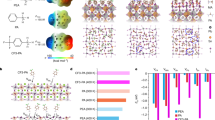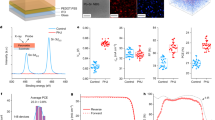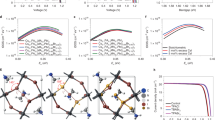Abstract
All-perovskite tandem solar cells provide high power conversion efficiency at a low cost1,2,3,4. Rapid efficiency improvement in small-area (<0.1 cm2) tandem solar cells has been primarily driven by advances in low-bandgap (approximately 1.25 eV) perovskite bottom subcells5,6,7. However, unsolved issues remain for wide-bandgap (> 1.75 eV) perovskite top subcells8, which at present have large voltage and fill factor losses, particularly for large-area (>1 cm2) tandem solar cells. Here we develop a self-assembled monolayer of (4-(7H-dibenzo[c,g]carbazol-7-yl)butyl)phosphonic acid as a hole-selective layer for wide-bandgap perovskite solar cells, which facilitates subsequent growth of high-quality wide-bandgap perovskite over a large area with suppressed interfacial non-radiative recombination, enabling efficient hole extraction. By integrating (4-(7H-dibenzo[c,g]carbazol-7-yl)butyl)phosphonic acid in devices, we demonstrate a high open-circuit voltage (VOC) of 1.31 V in a 1.77-eV perovskite solar cell, corresponding to a very low VOC deficit of 0.46 V (with respect to the bandgap). With these wide-bandgap perovskite subcells, we report 27.0% (26.4% certified stabilized) monolithic all-perovskite tandem solar cells with an aperture area of 1.044 cm2. The certified tandem cell shows an outstanding combination of a high VOC of 2.12 V and a fill factor of 82.6%. Our demonstration of the large-area tandem solar cells with high certified efficiency is a key step towards scaling up all-perovskite tandem photovoltaic technology.
This is a preview of subscription content, access via your institution
Access options
Access Nature and 54 other Nature Portfolio journals
Get Nature+, our best-value online-access subscription
$29.99 / 30 days
cancel any time
Subscribe to this journal
Receive 51 print issues and online access
$199.00 per year
only $3.90 per issue
Buy this article
- Purchase on Springer Link
- Instant access to full article PDF
Prices may be subject to local taxes which are calculated during checkout




Similar content being viewed by others
Data availability
All data are available in the paper or Supplementary Information. The data that support the findings of this study are available from the corresponding authors on reasonable request.
Code availability
The codes that support the findings of this study are available from the corresponding authors on reasonable request.
References
Eperon, G. E., Hörantner, M. T. & Snaith, H. J. Metal halide perovskite tandem and multiple-junction photovoltaics. Nat. Rev. Chem. 1, 0095 (2017).
Rajagopal, A. et al. Highly efficient perovskite–perovskite tandem solar cells reaching 80% of the theoretical limit in photovoltage. Adv. Mater. 29, 1702140 (2017).
Leijtens, T., Bush, K. A., Prasanna, R. & McGehee, M. D. Opportunities and challenges for tandem solar cells using metal halide perovskite semiconductors. Nat. Energy 3, 828–838 (2018).
Forgács, D. et al. Efficient monolithic perovskite/perovskite tandem solar cells. Adv. Energy Mater. 7, 1602121 (2017).
Tong, J. et al. Carrier lifetimes of >1 μs in Sn-Pb perovskites enable efficient all-perovskite tandem solar cells. Science 364, 475–479 (2019).
Zhao, D. et al. Efficient two-terminal all-perovskite tandem solar cells enabled by high-quality low-bandgap absorber layers. Nat. Energy 3, 1093–1100 (2018).
Lin, R. et al. All-perovskite tandem solar cells with improved grain surface passivation. Nature 603, 73–78 (2022).
Thiesbrummel, J. et al. Understanding and minimizing VOC losses in all-perovskite tandem photovoltaics. Adv. Energy Mater. 13, 2202674 (2022).
Eperon, G. E. et al. Perovskite-perovskite tandem photovoltaics with optimized band gaps. Science 354, 861–865 (2016).
Jiang, F. et al. A two-terminal perovskite/perovskite tandem solar cell. J. Mater. Chem. A 4, 1208–1213 (2016).
He, R. et al. Wide-bandgap organic-inorganic hybrid and all-inorganic perovskite solar cells and their application in all-perovskite tandem solar cells. Energy Environ. Sci. 14, 5723–5759 (2021).
Shockley, W. & Queisser, H. J. Detailed balance limit of efficiency of p-n junction solar cells. J. Appl. Phys. 32, 510–519 (1961).
Zhao, D. & Ding, L. All-perovskite tandem structures shed light on thin-film photovoltaics. Sci. Bull. 65, 1144–1146 (2020).
Green, M. A. et al. Solar cell efficiency tables (version 60). Prog. Photovolt. 30, 687–701 (2022).
Brinkmann, K. O. et al. Perovskite–organic tandem solar cells with indium oxide interconnect. Nature 604, 280–286 (2022).
Mahesh, S. et al. Revealing the origin of voltage loss in mixed-halide perovskite solar cells. Energy Environ. Sci. 13, 258–267 (2020).
Tan, H. et al. Dipolar cations confer defect tolerance in wide-bandgap metal halide perovskites. Nat. Commun. 9, 3100 (2018).
McMeekin, D. P. et al. A mixed-cation lead mixed-halide perovskite absorber for tandem solar cells. Science 351, 151–155 (2016).
Fu, F. et al. High-efficiency inverted semi-transparent planar perovskite solar cells in substrate configuration. Nat. Energy 2, 16190 (2016).
Liu, Y., Dong, B., Hagfeldt, A., Luo, J. & Graetzel, M. Chemically tailored molecular surface modifiers for efficient and stable perovskite photovoltaics. SmartMat 2, 33–37 (2021).
Yu, Z. et al. Simplified interconnection structure based on C60/SnO2-x for all-perovskite tandem solar cells. Nat. Energy 5, 657–665 (2020).
Li, C. et al. Low-bandgap mixed tin–lead iodide perovskites with reduced methylammonium for simultaneous enhancement of solar cell efficiency and stability. Nat. Energy 5, 768–776 (2020).
Xiao, K. et al. All-perovskite tandem solar cells with 24.2% certified efficiency and area over 1 cm2 using surface-anchoring zwitterionic antioxidant. Nat. Energy 5, 870–880 (2020).
Bi, C., Yuan, Y., Fang, Y. & Huang, J. Low-temperature fabrication of efficient wide-bandgap organolead trihalide perovskite solar cells. Adv. Energy Mater. 5, 1401616 (2015).
Hu, M., Bi, C., Yuan, Y., Bai, Y. & Huang, J. Stabilized wide bandgap MAPbBrxI3-x perovskite by enhanced grain size and improved crystallinity. Adv. Sci. 3, 1500301 (2016).
Al-Ashouri, A. et al. Monolithic perovskite/silicon tandem solar cell with >29% efficiency by enhanced hole extraction. Science 370, 1300–1309 (2020).
Li, L. et al. Flexible all-perovskite tandem solar cells approaching 25% efficiency with molecule-bridged hole-selective contact. Nat. Energy 7, 708–717 (2022).
Lai, H. et al. High-performance flexible all-perovskite tandem solar cells with reduced VOC-deficit in wide-bandgap subcell. Adv. Energy Mater. 12, 2202438 (2022).
Stolterfoht, M. et al. Approaching the fill factor Shockley–Queisser limit in stable, dopant-free triple cation perovskite solar cells. Energy Environ. Sci. 10, 1530–1539 (2017).
Ullah, A. et al. Novel phenothiazine-based self-assembled monolayer as a hole selective contact for highly efficient and stable p-i-n perovskite solar cells. Adv. Energy Mater. 12, 2103175 (2022).
Kapil, G. et al. Tin–lead perovskite solar cells fabricated on hole selective monolayers. ACS Energy Lett. 7, 966–974 (2022).
Du, F. et al. An unfused-ring acceptor with high side-chain economy enabling 11.17% as-cast organic solar cells. Mater. Horiz. 8, 1008–1016 (2021).
Zhao, S. et al. Cross-plane transport in a single-molecule two-dimensional van der Waals heterojunction. Sci. Adv. 6, eaba6714 (2020).
Wang, J. et al. Aza[5]helicene rivals N-annulated perylene as π-linker of D−π−D typed hole-transporters for perovskite solar cells. Adv. Funct. Mater. 30, 2002114 (2020).
Chen, B., Rudd, P. N., Yang, S., Yuan, Y. & Huang, J. Imperfections and their passivation in halide perovskite solar cells. Chem. Soc. Rev. 48, 3842–3867 (2019).
Lin, H.-C. et al. Influence of molecular orientation on charge-transfer processes at phthalocyanine/metal oxide interfaces and relationship to organic photovoltaic performance. J. Phys. Chem. C 119, 10304–10313 (2015).
Levine, I. et al. Charge transfer rates and electron trapping at buried interfaces of perovskite solar cells. Joule 5, 2915–2933 (2021).
Stolterfoht, M. et al. Visualization and suppression of interfacial recombination for high-efficiency large-area pin perovskite solar cells. Nat. Energy 3, 847–854 (2018).
Caprioglio, P. et al. On the relation between the open-circuit voltage and quasi‐fermi level splitting in efficient perovskite solar cells. Adv. Energy Mater. 9, 1901631 (2019).
Nayak, P. K., Mahesh, S., Snaith, H. J. & Cahen, D. Photovoltaic solar cell technologies: analysing the state of the art. Nat. Rev. Mater. 4, 269–285 (2019).
Jiang, Y. et al. Mitigation of vacuum and illumination-induced degradation in perovskite solar cells by structure engineering. Joule 4, 1087–1103 (2020).
Philippa, B. et al. The impact of hot charge carrier mobility on photocurrent losses in polymer-based solar cells. Sci. Rep. 4, 5695 (2014).
Le Corre, V. M. et al. Quantification of efficiency losses due to mobile ions in perovskite solar cells via fast hysteresis measurements. Sol. RRL 6, 2100772 (2022).
Chen, C. et al. Interfacial engineering of a thiophene-based 2D/3D perovskite heterojunction for efficient and stable inverted wide-bandgap perovskite solar cells. Nano Energy 90, 106608 (2021).
Martínez, L., Andrade, R., Birgin, E. G. & Martínez, J. M. PACKMOL: a package for building initial configurations for molecular dynamics simulations. J. Comput. Chem. 30, 2157–2164 (2009).
Jorgensen, W. L., Maxwell, D. S. & Tirado-Rives, J. Development and testing of the OPLS all-atom force field on conformational energetics and properties of organic liquids. J. Am. Chem. Soc. 118, 11225–11236 (1996).
Lorenzoni, A., Mosca Conte, A., Pecchia, A. & Mercuri, F. Nanoscale morphology and electronic coupling at the interface between indium tin oxide and organic molecular materials. Nanoscale 10, 9376–9385 (2018).
Plimpton, S. Fast parallel algorithms for short-range molecular dynamics. J. Comput. Phys. 117, 1–19 (1995).
Wei, K. et al. Facile exfoliation of the perovskite thin film for visualizing the buried interfaces in perovskite solar cells. ACS Appl. Energy Mater. 5, 7458–7465 (2022).
Acknowledgements
This work was financially supported by the National Key Research and Development Program of China (no. 2019YFE0120000), the National Natural Science Foundation of China (nos. 62174112, 62005188 and 21875111), the Fundamental Research Funds for the Central Universities (nos. YJ201955 and YJ2021157), the Science and Technology Program of Sichuan Province (no. 2020JDJQ0030), the Engineering Featured Team Fund of Sichuan University (2020SCUNG102), the Research Funds from Tan Kah Kee Innovation Laboratory (HRTP-[2022]-45), the Key R&D Program of Natural Science Foundation of Jiangsu Province (BE2019733), the Natural Science Foundation of Jiangsu Province (BK20190825), open foundation of State Key Laboratory of Featured Metal Materials and Life-Cycle Safety for Composite Structures, Guangxi University (grant no. 2022GXYSOF05) and Key Lab of Advanced Optical Manufacturing Technologies of Jiangsu Province and Key Lab of Modern Optical Technologies of Education Ministry of China, Soochow University (no. KJS1909). F.F. acknowledges funding from the Swiss National Science Foundation (no. 200021_213073/1) and European Union’s Horizon Europe research and innovation programme under grant agreement no. 101075605. We acknowledge funding from the Deutsche Forschungsgemeinschaft in the SPP 2196 (HIPSTER 424709669 and SURPRISE 423749265). M.S. further acknowledges the Heisenberg programme from the Deutsche Forschungsgemeinschaft (DFG, German Research Foundation) for funding (project no. 498155101). F.L. acknowledges funding by the Volkswagen Foundation through the Freigeist Program. We also acknowledge Jihua Zou for measuring confocal PL mapping of WBG perovskites.
Author information
Authors and Affiliations
Contributions
D.Z., F.F., W.T. and C.C. conceived and designed the research. R.H. carried out the fabrication and main characterizations of WBG PVSK films and devices. W.W., J. Zhou. and W.T. synthesized the SAMs and provided the relevant characterizations of SAMs. R.H., Z.Y., Y.L., J.L. and J. Zhu fabricated all-PVSK tandem devices. J.L. and J. Zhu helped to optimize the LBG devices. F.L., J.T., S.S. and M.S. performed the RPV measurements, the fast hysteresis measurements, the PLQY and electroluminescence-related characterizations and constructed the p-JV of WBG PSCs and TSCs. C.W. performed EQE measurements. H.L. and F.F. carried out TPV and EIS measurements. H.H. and B.Z. performed PiFM measurements. X.Y. synthesized the molecule 2-thiopheneethylammonium chloride. M.S. performed numerical simulations of WBG PVSKs and helped to analyse the results. K.W. and Jinbao Zhang performed the exfoliation of WBG PVSK and characterized the photoluminescence mapping and SEM of the buried interface. R.H., C.C., F.F. and D.Z. wrote the manuscript with inputs from all co-authors. All authors discussed the results and reviewed the manuscript. D.Z. directed this project.
Corresponding authors
Ethics declarations
Competing interests
The authors declare no competing interests.
Peer review
Peer review information
Nature thanks Anita Ho-Baillie, Lijun Zhang and the other, anonymous, reviewer(s) for their contribution to the peer review of this work.
Additional information
Publisher’s note Springer Nature remains neutral with regard to jurisdictional claims in published maps and institutional affiliations.
Supplementary information
Supplementary Information
This file contains Supplementary Figs. 1–29, Supplementary Notes 1–2, Supplementary Discussion 1–3, Supplementary Tables 1–7 and Supplementary References.
Rights and permissions
Springer Nature or its licensor (e.g. a society or other partner) holds exclusive rights to this article under a publishing agreement with the author(s) or other rightsholder(s); author self-archiving of the accepted manuscript version of this article is solely governed by the terms of such publishing agreement and applicable law.
About this article
Cite this article
He, R., Wang, W., Yi, Z. et al. Improving interface quality for 1-cm2 all-perovskite tandem solar cells. Nature 618, 80–86 (2023). https://doi.org/10.1038/s41586-023-05992-y
Received:
Accepted:
Published:
Issue Date:
DOI: https://doi.org/10.1038/s41586-023-05992-y
This article is cited by
-
Electron-withdrawing organic ligand for high-efficiency all-perovskite tandem solar cells
Nature Energy (2024)
-
Efficient all-small-molecule organic solar cells processed with non-halogen solvent
Nature Communications (2024)
-
Mixed tin-lead perovskites with balanced crystallization and oxidation barrier for all-perovskite tandem solar cells
Nature Communications (2024)
-
Resolving electron and hole transport properties in semiconductor materials by constant light-induced magneto transport
Nature Communications (2024)
-
Methylammonium-free wide-bandgap metal halide perovskites for tandem photovoltaics
Nature Reviews Materials (2023)
Comments
By submitting a comment you agree to abide by our Terms and Community Guidelines. If you find something abusive or that does not comply with our terms or guidelines please flag it as inappropriate.



